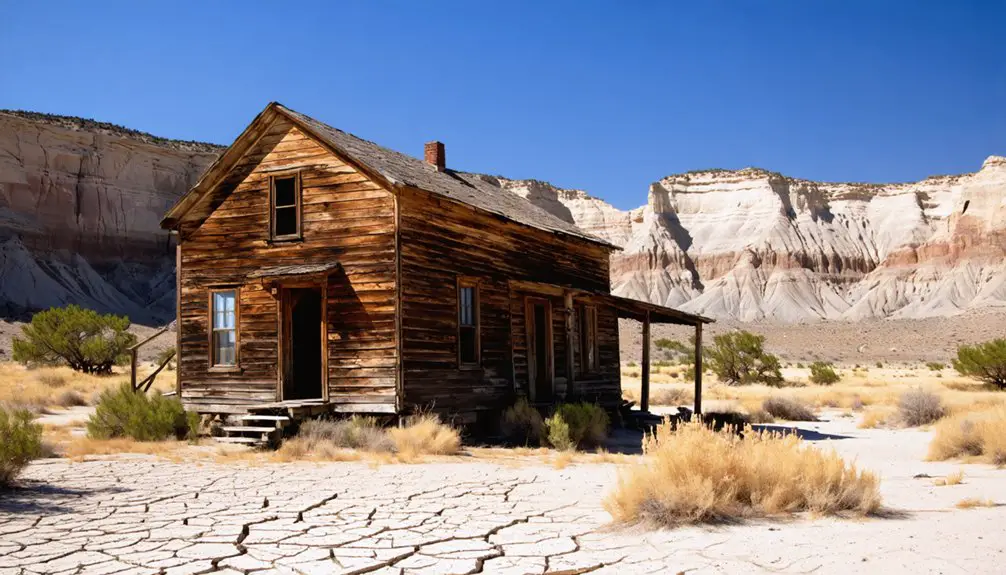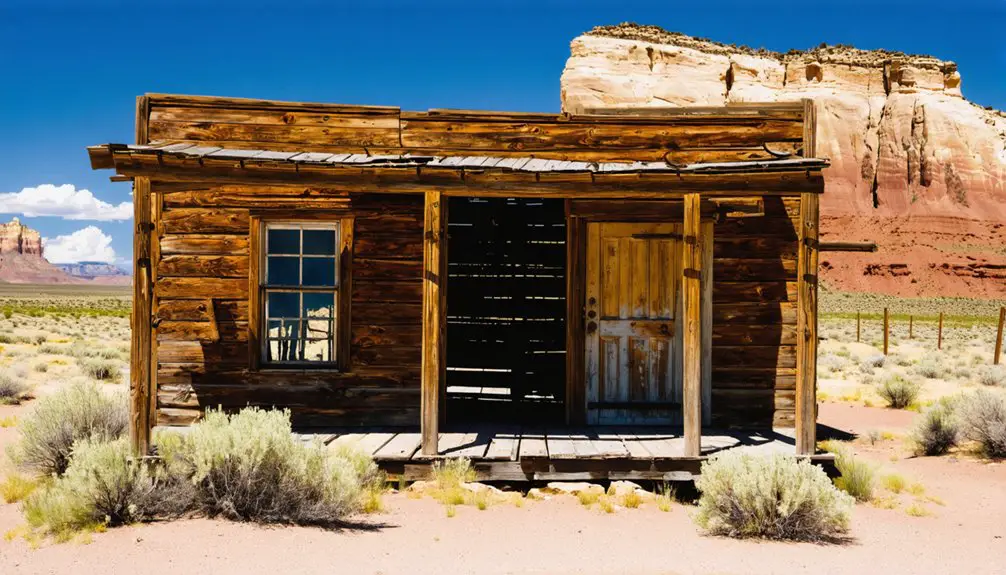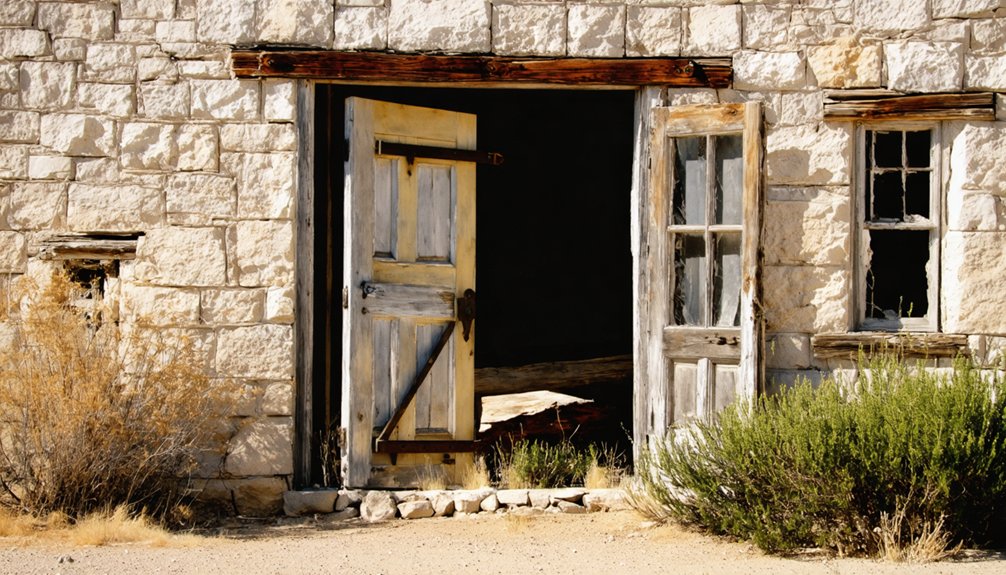You’ll find Hamblin’s ghost town ruins in Utah’s Mountain Meadow Valley, where a thriving Mormon settlement once stood in the mid-1800s. The town flourished between 1856-1870 as an essential hub along the Mormon Road, with settlers engaging in dairy commerce and community life within fort walls. Despite Jacob Hamblin’s diplomatic success with Native Americans, the settlement couldn’t overcome harsh environmental challenges, including flash floods and poor soil conditions. The town’s remaining cellar pits and building foundations tell a compelling frontier tale.
Key Takeaways
- Hamblin was a mid-19th century Mormon settlement along the Mormon Road that thrived from 1856 to 1870 before becoming a ghost town.
- The town’s remains include roofless ruins, cellar pits, and basements constructed with square-headed nails and corrugated metal roofing.
- Environmental challenges including flash floods, poor soil, and water scarcity ultimately led to the town’s abandonment by 1890.
- During its peak, Hamblin served as a dairy commerce hub, with settlers selling butter and cheese to passing wagon trains.
- The settlement was founded by Jacob Hamblin, who built infrastructure and fostered peaceful relations with Native American tribes.
The Mormon Pioneer Origins
As the early Mormon movement gained momentum in the 1840s, Jacob Hamblin emerged as a pivotal figure in Utah’s territorial expansion. After encountering Mormon preachers in 1842, he converted to the LDS Church and joined the growing community in Nauvoo, Illinois.
Jacob Hamblin’s conversion to Mormonism in 1842 launched his influential role in expanding Utah’s territory and shaping its early settlements.
When Joseph Smith was assassinated, Hamblin stood firmly behind Brigham Young’s leadership.
You’ll find Hamblin’s pioneer migration story intertwined with the broader Mormon exodus west. By 1850, he’d established himself in Tooele, marking one of the early settlements in Utah Territory.
His influence grew when Young called him to serve as a missionary to the southern Paiute Indians in 1854, leading him to found the Santa Clara settlement that same year. This strategic placement would shape both Mormon colonization and Native American relations in southern Utah. He became renowned for his role as the “Buckskin Apostle” through his diplomatic work between settlers and Native American tribes. He built a remarkable sandrock home in 1863 that served as both residence and community gathering place.
Life in Mountain Meadow Valley
While Jacob Hamblin worked to establish Mormon settlements, Mountain Meadow Valley’s unique environment shaped the lives of its earliest inhabitants. You’d find abundant cold springs and lush grasses that made the valley a natural stopping point for California-bound travelers. Parley P. Pratt once described the area as paradise in 1851. The valley contained vast areas of semi-natural grasslands that supported diverse native plant species.
Community cooperation became essential as Mormon families built settlements like Meadow Creek, practicing mixed farming and grazing while managing scarce resources during harsh times.
The valley’s transformation was dramatic – from grassland to desert shrub. The devastating drought of the 1850s strained relationships between settlers and emigrants, while the 1884 floods carved deep washes through the landscape.
You’ll notice how agricultural development altered the valley’s character, as non-native species replaced natural vegetation and riparian growth changed the watercourses, marking a permanent shift in Mountain Meadow’s ecology.
Jacob Hamblin’s Vision and Legacy
You’ll find Jacob Hamblin’s most enduring legacy in his dedication to peaceful Native American relations, where he mastered Paiute and Ute languages to bridge cultural divides between Mormon settlers and indigenous peoples.
His missionary work expanded settlements across southwestern Utah while establishing essential infrastructure like Lee’s Ferry, which served as a significant Colorado River crossing point for over fifty years. After moving to the area, he helped construct an important adobe fort in Santa Clara. Fighting against Goshutes during cattle raids pushed him toward peaceful diplomacy with native tribes.
Through patient diplomacy and cross-cultural understanding, Hamblin’s crowning achievement came in negotiating the Fort Defiance Treaty of 1870, which brought lasting peace between Navajo tribes and Mormon settlers.
Peaceful Native American Relations
Through his extraordinary commitment to peace and cultural understanding, Jacob Hamblin established himself as an essential bridge between Mormon settlers and Native American tribes in southwestern Utah. His mastery of Paiute and Ute languages, combined with deep cultural empathy, enabled him to navigate complex disputes and foster peaceful coexistence between diverse communities.
As president of the Santa Clara Indian Mission, you’ll find that Hamblin’s approach emphasized compromise over conflict. He translated during critical expeditions, including John Wesley Powell’s Colorado River journey, while building trust through consistent diplomacy. His dedicated work with the Gosuite and Paiute tribes shaped the foundation for successful settlement negotiations in the region. His ten missionary journeys to visit the Hopi Indians demonstrated his tireless dedication to building lasting relationships.
Even when facing personal danger, he demonstrated unwavering courage, especially during the 1874 Navajo peace negotiations. Under Brigham Young’s direction, Hamblin’s peaceful methods helped secure important travel corridors and establish settlements while maintaining respectful relationships with Native American communities.
Mission and Settlement Expansion
Jacob Hamblin’s diplomatic achievements with Native American tribes laid the groundwork for his broader vision of Mormon settlement expansion.
His strategic settlement planning focused on resource-rich locations like Skutumpah Valley, while his missionary outreach stretched across 450 miles from the Great Salt Lake Valley to the Colorado River basin.
You’ll find Hamblin’s influence most evident in his settlement logistics, as he established essential transit points like Lee’s Ferry in 1873.
His home in Santa Clara became a significant base for coordinating both missionary work and settlement growth. His dedication to peace and cooperation earned him respect from the Paiutes and Navajos during his 32-year mission service.
Through his roles as Paiute interpreter and regional guide, he helped create a network of interdependent communities along mountain edges and waterways. Hamblin’s missionary efforts reflected broader religious activities aimed at civilizing and assimilating Native Americans.
His collaboration with explorers like John Wesley Powell enhanced geographic knowledge, enabling informed decisions about where to establish sustainable Mormon settlements throughout southern Utah and northern Arizona.
Building Cross-Cultural Bridges
While many frontier settlers advocated force in Native American relations, Hamblin’s approach centered on peaceful diplomacy and cross-cultural understanding. After his gun failed during a confrontation with Native Americans, he vowed never to shed Indian blood, instead pursuing cultural diplomacy through language learning and peaceful negotiation.
You’ll find that Hamblin’s indigenous pedagogy went beyond mere translation – he married Native women, adopted Native children, and served as an official intermediary between settlers and tribes. He mastered Paiute and Ute languages, enabling him to resolve conflicts and build lasting partnerships across the Southwest.
As both an LDS missionary and Indian agent, he balanced religious objectives with respect for Native sovereignty, helping establish multicultural communities like Santa Clara and Kanab while lamenting the displacement of indigenous peoples from their lands.
Natural Challenges and Environmental Impact

You’ll find that Hamblin’s position in Mountain Meadow exposed it to devastating flash floods that repeatedly damaged structures and eroded essential agricultural areas.
The combination of poor soil composition and harsh mountain valley weather created significant challenges for farming, with crops struggling to survive in the rocky, nutrient-deficient earth.
The settlement’s higher elevation of 5,832 feet subjected residents to extreme temperature swings and unpredictable weather patterns that made sustainable agriculture nearly impossible.
Flash Flood Destruction Pattern
Although Hamblin’s settlers faced numerous challenges, the devastating pattern of flash floods proved particularly destructive to this southwestern Utah settlement.
You’ll find that intense thunderstorms would dump several inches of rain in just hours, sending destructive torrents through the steep canyons and narrow valleys. These flood patterns repeatedly damaged agricultural lands, washed away crops, and undermined building foundations.
When combined with overgrazing, the floods accelerated soil erosion and permanently altered drainage patterns. You can see how settlement challenges mounted as floodwaters carried massive loads of sediment and debris downstream, reshaping the landscape.
Agricultural Land Degradation
The harsh realities of agricultural land degradation in Hamblin emerged through a complex interplay of natural and human-induced factors.
You’ll find evidence of how the lack of soil conservation practices led to severe erosion, particularly in areas where overgrazing and excessive cultivation stripped away protective vegetation.
The semi-arid climate at 5,832 feet elevation made sustainable agriculture challenging, with nutrient depletion and wind erosion devastating topsoil quality.
Without proper erosion control measures, the loss of native plants weakened soil structure while seasonal rainfall patterns caused uneven nutrient leaching.
The absence of land restoration efforts, combined with harsh temperature extremes and limited water resources, ultimately contributed to declining crop yields.
These conditions created a cycle of deterioration that made traditional farming increasingly difficult to maintain.
Mountain Valley Weather Effects
When examining Hamblin’s mountain valley climate, dramatic temperature swings and sparse precipitation created significant environmental challenges.
Weather extremes shaped both the landscape and its ecological impact through intense natural forces that you’d witness throughout the seasons.
- Temperature fluctuations between 22°F and 93°F drove physical weathering, while mountain areas stayed 20°F cooler than valley floors.
- Limited annual rainfall of 7 inches, coupled with sudden summer downpours, triggered flash floods and rapid erosion.
- Persistent winds averaging 8-11 mph generated dust clouds and accelerated soil degradation.
- Freeze-thaw cycles during shoulder seasons fractured rocks, while variable snowmelt timing affected downstream water availability.
These harsh conditions steadily eroded the valley’s resources, making sustainable agriculture and settlement increasingly difficult to maintain.
The Settlement’s Golden Years

During its peak years between 1856 and 1870, Hamblin’s settlement flourished as an essential hub along the Mormon Road, serving both emigrants and local residents.
You’d find bustling dairy commerce, with settlers selling butter and cheese to passing wagon trains, contributing to the settlement’s prosperity. Community cohesion thrived within the fort walls, where families maintained a schoolhouse and functional living spaces.
Jacob Hamblin’s diplomatic success with Native American tribes enhanced the settlement’s golden era. His mastery of indigenous languages and peacekeeping efforts, culminating in the 1870 Navajo treaty, created a unique environment where settlers and native peoples coexisted.
The settlement adapted to challenges, constructing stronger stone buildings after floods and maintaining seasonal residences that maximized the region’s natural advantages.
Decline of a Pioneer Community
Despite its promising beginnings, Hamblin’s decline began with environmental mismanagement that would ultimately seal its fate.
Environmental neglect marked the beginning of the end for Hamblin, transforming a hopeful settlement into a cautionary tale.
The community’s resilience was tested as overgrazing and resource depletion transformed the once-thriving meadow ecosystem.
You’ll find the settlement’s downfall followed this devastating progression:
- Continuous overuse led to severe erosion, dried-up springs, and frequent flooding
- The declining Mormon Road traffic crippled the town’s economic sustainability
- Environmental degradation forced families to seek more viable land elsewhere
- By 1890, the exodus left only a cemetery as evidence of the former settlement
The intersection of environmental strain and shifting transportation routes proved insurmountable.
What began as a promising pioneer town succumbed to the harsh realities of resource mismanagement and changing economic landscapes.
Preserving Historical Remnants

Although time has claimed much of Hamblin’s original settlement, significant preservation efforts have secured essential historical remnants across the region.
You’ll find the Jacob Hamblin Home stands as a cornerstone of historical preservation, offering free daily tours where LDS missionaries guide you through its 1860s appearance and rich pioneer history.
Archaeological documentation has meticulously mapped the Hamlin Valley Trap Site, recording 88 stumps, 16 brace trees, and 166 juniper elements.
You can explore the Pine Valley chapel, uniquely constructed like a ship’s hull by Ebenezer Bryce, which continues to draw seasonal visitors.
Through collaborative efforts between Utah SHPO, Nevada SHPO, and SITLA, these sites remain protected despite environmental challenges like erosion and natural decay, ensuring you can experience authentic pieces of pioneer heritage.
Native American Relations and Influence
While serving as a sub-Indian agent from 1858 onward, Jacob Hamblin played a significant role in shaping Native American relations across the Utah Territory. His unique approach to cultural exchange and religious influence set him apart from typical settler-Native interactions of the time.
You’ll find Hamblin’s legacy reflected in these key impacts:
- Established peaceful dialogue with tribes, serving as both protector and guide for travelers through Native lands.
- Introduced Mormon teachings while respecting Hopi traditions, particularly in northern Arizona.
- Founded settlements that became vital points of Native-Mormon interaction.
- Mediated conflicts and testified in legal trials, helping avoid violence between settlers and tribes.
His diplomatic efforts ultimately influenced how local tribes viewed Mormon settlers, making peaceful coexistence more achievable in the region.
Geographic Features and Settlement Layout
Nestled in Mountain Meadow of western Washington County, Utah, the ghost town of Hamblin occupies a strategic position at 5,832 feet elevation along the historic Mormon Road. The topographical features include rugged hills, distant peaks, and natural arches that surround the relatively flat meadowland where pioneers established their community in 1856.
The settlement patterns reveal careful planning, with wooden structures aligned along the Mormon Road to facilitate trade and travel.
You’ll find evidence of the town’s mid-19th century origins in the remaining roofless ruins, cellar pits, and basements that utilized square-headed nails and corrugated metal roofing.
The layout maximized access to seasonal water sources from mountain runoff and nearby washes, though these limited resources ultimately contributed to the town’s abandonment.
Frequently Asked Questions
What Artifacts Have Been Discovered at the Hamblin Ghost Town Site?
You’ll find diverse artifact types including Chinese currency, porcelain bowls, food remnants, dental powder, household items, and glass shards – all holding historical significance for understanding 19th-century railroad community life.
Are There Any Documented Paranormal Experiences in Hamblin’s Abandoned Structures?
You’ll find documented ghost sightings centered on the “White Lady” spirit, with EVP recordings and environmental disturbances captured by paranormal investigators. Supernatural encounters include unexplained sounds and visual manifestations near historic structures.
How Accessible Is the Ghost Town Site to Modern-Day Visitors?
You’ll find the ghost town accessible via well-maintained gravel roads suitable for standard vehicles. Pack supplies and check weather conditions, as there aren’t any visitor facilities or modern amenities on-site.
What Restoration Projects Have Been Attempted Since the Town’s Abandonment?
You’ll find ongoing restoration efforts focusing on underground mine shafts reaching 900 feet deep, with community involvement in electrical installations, structural preservation of pioneer buildings, and volunteer-driven mapping of historical sites.
Did Any Businesses Besides Farming Operations Exist in Hamblin?
Like a desert mirage, businesses in Hamblin were sparse. You’ll find no mining operations or bustling trade – just home-based textile work, tanning, and basic agricultural processing supporting the town’s self-sufficient lifestyle.
References
- https://en.wikipedia.org/wiki/Jacob_Hamblin
- https://en.wikipedia.org/wiki/Hamblin
- https://www.youtube.com/watch?v=2TiPLCv72W4
- https://onlineutah.us/hamblinhistory.shtml
- https://www.deseret.com/2016/7/23/20592661/the-tiny-town-that-set-out-to-be-utah-s-capitol-and-4-other-areas-with-a-unique-history/
- https://wchsutah.org/homes/jacob-hamblin-home.php
- https://en.wikipedia.org/wiki/Jacob_Hamblin_House
- https://community.utah.gov/todd-compton-on-a-frontier-life-jacob-hamblin-explorer-and-indian-missionary-published-2013/
- https://history.churchofjesuschrist.org/content/historic-sites/utah/st-george/four-things-you-might-not-know-about-jacob-hamblin?lang=eng
- https://pubs.usgs.gov/imap/2173/report.pdf



